The maintenance of internal favourable conditions, by a self-regulated mechanisms in spite of the fact that there are changes in environment, is known as
Homeostasis
Entropy
Enthalpy
Steady state
The correct Answer is:A
To solve the question, "The maintenance of internal favourable conditions, by a self-regulated mechanism in spite of the fact that there are changes in the environment, is known as," we will analyze the options provided and determine the correct answer step by step.
1. Understanding the Question:
- The question describes a process that maintains stable internal conditions despite external changes. This concept is crucial in biology, particularly in understanding how organisms survive in varying environments.
2. Analyzing the Options:
- The options given are:
- A) Homeostasis
- B) Entropy
- C) Enthalpy
- D) Steady State
3. Evaluating Each Option:
- A) Homeostasis:
- Homeostasis refers to the ability of an organism to regulate its internal environment to maintain stable, constant conditions (e.g., temperature, pH) despite changes in the external environment. This is a self-regulating process.
- B) Entropy:
- Entropy is a concept from thermodynamics that measures the disorder or randomness in a system. It does not relate to the maintenance of stable internal conditions.
- C) Enthalpy:
- Enthalpy refers to the total heat content of a system and is related to heat changes during chemical reactions. It is not concerned with internal regulation.
- D) Steady State:
- Steady state refers to a condition where certain variables remain constant over time. While it can be related to homeostasis, it is more specific to cellular levels and does not encompass the entire organism's regulation.
4. Conclusion:
- Based on the definitions and explanations of each term, the correct answer is A) Homeostasis. Homeostasis is the term that best fits the description of maintaining internal favourable conditions through self-regulated mechanisms.
Final Answer:
Homeostasis
- The question describes a process that maintains stable internal conditions despite external changes. This concept is crucial in biology, particularly in understanding how organisms survive in varying environments.
- The options given are:
- A) Homeostasis
- B) Entropy
- C) Enthalpy
- D) Steady State
- A) Homeostasis:
- Homeostasis refers to the ability of an organism to regulate its internal environment to maintain stable, constant conditions (e.g., temperature, pH) despite changes in the external environment. This is a self-regulating process.
- B) Entropy:
- Entropy is a concept from thermodynamics that measures the disorder or randomness in a system. It does not relate to the maintenance of stable internal conditions.
- C) Enthalpy:
- Enthalpy refers to the total heat content of a system and is related to heat changes during chemical reactions. It is not concerned with internal regulation.
- D) Steady State:
- Steady state refers to a condition where certain variables remain constant over time. While it can be related to homeostasis, it is more specific to cellular levels and does not encompass the entire organism's regulation.
- Based on the definitions and explanations of each term, the correct answer is A) Homeostasis. Homeostasis is the term that best fits the description of maintaining internal favourable conditions through self-regulated mechanisms.
Homeostasis
Similar Questions
Knowledge Check
The maintenance of internal conditions of an organism within a certain boundary range is called :
AevolutionBmetabolismCadaptationDhomeostasisEnvironmentalist Otters
It has long been known that the sea otters (23) living along the West Coast of North America help––––––––––––––––––––––––––––––––––––––––––––––––––––––– keep kelp forests in their habitat healthy and vital. They do this by feeding on sea urchins and other herbivorous invertebrates that graze voraciously on kelp. With sea otters to keep the population of sea urchins in check, kelp forests can flourish. In fact, (24) two years or less of sea otters can completely eliminate sea urchins––––––––––––––––––––––––––––––––––––––––––––––––––––––––––––––––––––––– in a coastal area (see chart).
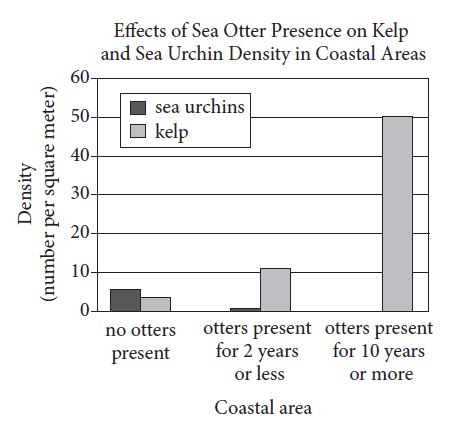
Adapted from David O. Duggins, “Kelp Beds and Sea Otters: An Experimental Approach.” ©1980 by the Ecological Society of America.
Without sea otters present, (25) nevertheless–––––––––––––, kelp forests run the danger of becoming barren stretches of coastal wasteland known as urchin barrens.
[1] What was less well-known, until recently at least, was how this relationship among sea otters, sea urchins, and kelp forests might help fight global warming. [2] The amount of carbon dioxide in the atmosphere has increased 40 percent (26) . [3] A recent study by two professors at the University of California, Santa Cruz, Chris Wilmers and James Estes, (27) suggests, that––––––––––––––– kelp forests protected by sea otters can absorb as much as twelve times the amount of carbon dioxide from the atmosphere as those where sea urchins are allowed to (28) devour–––––––– the kelp. [4] Like (29) their––––– terrestrial plant cousins, kelp removes carbon dioxide from the atmosphere, turning it into sugar fuel through photosynthesis, and releases oxygen back into the air.
[5] Scientists knew this but did not recognize (30) how large a role they played–––––––––––––––––––––––––––––– in helping kelp forests to significantly decrease the amount of carbon dioxide in the atmosphere. [6] Far from making no difference to the ecosystem, the presence of otters was found to increase the carbon storage of kelp forests by 4.4 to 8.7 megatons annually, offsetting the amount of carbon dioxide emitted by three million to six million passenger cars each year. (31)
Wilmers and Estes caution, however, that (32) having more otters––––––––––––––––––––– will not automatically solve the problem of higher levels of carbon dioxide in the air. But they suggest that the presence of otters provides a good model of how carbon can be sequestered, (33) or removed, from––––––––––––––––––– the atmosphere through the management of animal populations. If ecologists can better understand what kinds of impacts animals might have on the environment, Wilmers contends, “there might be opportunities for win-win conservation scenarios, whereby animal species are protected or enhanced, and carbon gets sequestered.”ANO CHANGEBsuggests—thatCsuggests, “thatDsuggests thatEnvironmentalist Otters
It has long been known that the sea otters (23) living along the West Coast of North America help––––––––––––––––––––––––––––––––––––––––––––––––––––––– keep kelp forests in their habitat healthy and vital. They do this by feeding on sea urchins and other herbivorous invertebrates that graze voraciously on kelp. With sea otters to keep the population of sea urchins in check, kelp forests can flourish. In fact, (24) two years or less of sea otters can completely eliminate sea urchins––––––––––––––––––––––––––––––––––––––––––––––––––––––––––––––––––––––– in a coastal area (see chart).
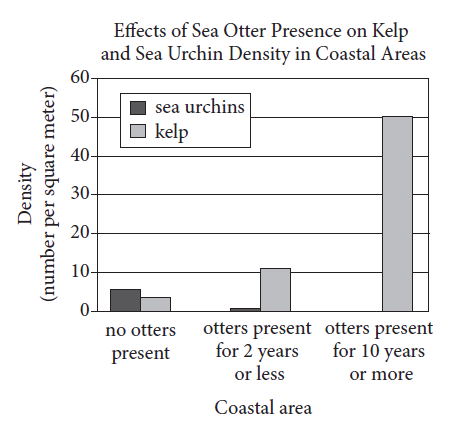
Adapted from David O. Duggins, “Kelp Beds and Sea Otters: An Experimental Approach.” ©1980 by the Ecological Society of America.
Without sea otters present, (25) nevertheless–––––––––––––, kelp forests run the danger of becoming barren stretches of coastal wasteland known as urchin barrens.
[1] What was less well-known, until recently at least, was how this relationship among sea otters, sea urchins, and kelp forests might help fight global warming. [2] The amount of carbon dioxide in the atmosphere has increased 40 percent (26) . [3] A recent study by two professors at the University of California, Santa Cruz, Chris Wilmers and James Estes, (27) suggests, that––––––––––––––– kelp forests protected by sea otters can absorb as much as twelve times the amount of carbon dioxide from the atmosphere as those where sea urchins are allowed to (28) devour–––––––– the kelp. [4] Like (29) their––––– terrestrial plant cousins, kelp removes carbon dioxide from the atmosphere, turning it into sugar fuel through photosynthesis, and releases oxygen back into the air.
[5] Scientists knew this but did not recognize (30) how large a role they played–––––––––––––––––––––––––––––– in helping kelp forests to significantly decrease the amount of carbon dioxide in the atmosphere. [6] Far from making no difference to the ecosystem, the presence of otters was found to increase the carbon storage of kelp forests by 4.4 to 8.7 megatons annually, offsetting the amount of carbon dioxide emitted by three million to six million passenger cars each year. (31)
Wilmers and Estes caution, however, that (32) having more otters––––––––––––––––––––– will not automatically solve the problem of higher levels of carbon dioxide in the air. But they suggest that the presence of otters provides a good model of how carbon can be sequestered, (33) or removed, from––––––––––––––––––– the atmosphere through the management of animal populations. If ecologists can better understand what kinds of impacts animals might have on the environment, Wilmers contends, “there might be opportunities for win-win conservation scenarios, whereby animal species are protected or enhanced, and carbon gets sequestered.”ANO CHANGEBliving along the West Coast of North America, they helpCthat live along the West Coast of North America and help toDthat live along the West Coast of North America, where they help
Homeostasis is a. disturbance in regulatory control b. tendency to resist internal changes c. plant and animal extracts used in homeopathy d. a tendency to change to change in environment
View SolutionGiven below are the diagrams of a certain structure in plants in two conditions :
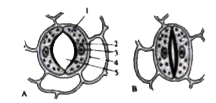
Describe the mechanism which brings about the change in the structures depicted in A and B.
View SolutionHow many statement are correct regarding all succession :-
(i) composition & structure of communities constantly change with the changing environmental conditions.
(ii) The change is orderly & sequential, parallel with the change in the physical environment
(iii) Change leads finally to a community is unstable .
View SolutionEnvironmentalist Otters
It has long been known that the sea otters (23) living along the West Coast of North America help––––––––––––––––––––––––––––––––––––––––––––––––––––––– keep kelp forests in their habitat healthy and vital. They do this by feeding on sea urchins and other herbivorous invertebrates that graze voraciously on kelp. With sea otters to keep the population of sea urchins in check, kelp forests can flourish. In fact, (24) two years or less of sea otters can completely eliminate sea urchins––––––––––––––––––––––––––––––––––––––––––––––––––––––––––––––––––––––– in a coastal area (see chart).
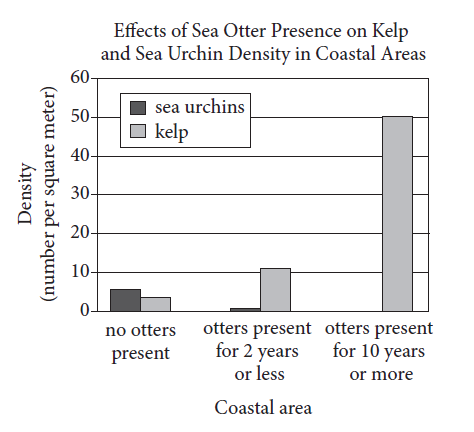
Adapted from David O. Duggins, “Kelp Beds and Sea Otters: An Experimental Approach.” ©1980 by the Ecological Society of America.
Without sea otters present, (25) nevertheless–––––––––––––, kelp forests run the danger of becoming barren stretches of coastal wasteland known as urchin barrens.
[1] What was less well-known, until recently at least, was how this relationship among sea otters, sea urchins, and kelp forests might help fight global warming. [2] The amount of carbon dioxide in the atmosphere has increased 40 percent (26) . [3] A recent study by two professors at the University of California, Santa Cruz, Chris Wilmers and James Estes, (27) suggests, that––––––––––––––– kelp forests protected by sea otters can absorb as much as twelve times the amount of carbon dioxide from the atmosphere as those where sea urchins are allowed to (28) devour–––––––– the kelp. [4] Like (29) their––––– terrestrial plant cousins, kelp removes carbon dioxide from the atmosphere, turning it into sugar fuel through photosynthesis, and releases oxygen back into the air.
[5] Scientists knew this but did not recognize (30) how large a role they played–––––––––––––––––––––––––––––– in helping kelp forests to significantly decrease the amount of carbon dioxide in the atmosphere. [6] Far from making no difference to the ecosystem, the presence of otters was found to increase the carbon storage of kelp forests by 4.4 to 8.7 megatons annually, offsetting the amount of carbon dioxide emitted by three million to six million passenger cars each year. (31)
Wilmers and Estes caution, however, that (32) having more otters––––––––––––––––––––– will not automatically solve the problem of higher levels of carbon dioxide in the air. But they suggest that the presence of otters provides a good model of how carbon can be sequestered, (33) or removed, from––––––––––––––––––– the atmosphere through the management of animal populations. If ecologists can better understand what kinds of impacts animals might have on the environment, Wilmers contends, “there might be opportunities for win-win conservation scenarios, whereby animal species are protected or enhanced, and carbon gets sequestered.”
View SolutionEnvironmentalist Otters
It has long been known that the sea otters (23) living along the West Coast of North America help––––––––––––––––––––––––––––––––––––––––––––––––––––––– keep kelp forests in their habitat healthy and vital. They do this by feeding on sea urchins and other herbivorous invertebrates that graze voraciously on kelp. With sea otters to keep the population of sea urchins in check, kelp forests can flourish. In fact, (24) two years or less of sea otters can completely eliminate sea urchins––––––––––––––––––––––––––––––––––––––––––––––––––––––––––––––––––––––– in a coastal area (see chart).
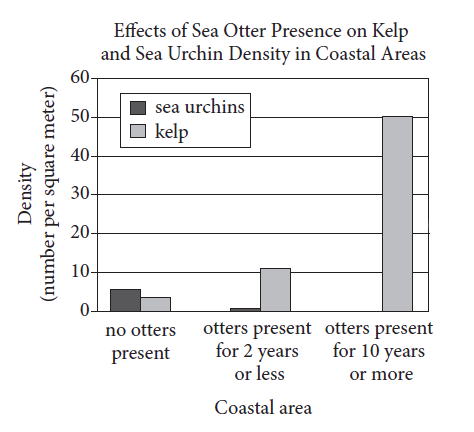
Adapted from David O. Duggins, “Kelp Beds and Sea Otters: An Experimental Approach.” ©1980 by the Ecological Society of America.
Without sea otters present, (25) nevertheless–––––––––––––, kelp forests run the danger of becoming barren stretches of coastal wasteland known as urchin barrens.
[1] What was less well-known, until recently at least, was how this relationship among sea otters, sea urchins, and kelp forests might help fight global warming. [2] The amount of carbon dioxide in the atmosphere has increased 40 percent (26) . [3] A recent study by two professors at the University of California, Santa Cruz, Chris Wilmers and James Estes, (27) suggests, that––––––––––––––– kelp forests protected by sea otters can absorb as much as twelve times the amount of carbon dioxide from the atmosphere as those where sea urchins are allowed to (28) devour–––––––– the kelp. [4] Like (29) their––––– terrestrial plant cousins, kelp removes carbon dioxide from the atmosphere, turning it into sugar fuel through photosynthesis, and releases oxygen back into the air.
[5] Scientists knew this but did not recognize (30) how large a role they played–––––––––––––––––––––––––––––– in helping kelp forests to significantly decrease the amount of carbon dioxide in the atmosphere. [6] Far from making no difference to the ecosystem, the presence of otters was found to increase the carbon storage of kelp forests by 4.4 to 8.7 megatons annually, offsetting the amount of carbon dioxide emitted by three million to six million passenger cars each year. (31)
Wilmers and Estes caution, however, that (32) having more otters––––––––––––––––––––– will not automatically solve the problem of higher levels of carbon dioxide in the air. But they suggest that the presence of otters provides a good model of how carbon can be sequestered, (33) or removed, from––––––––––––––––––– the atmosphere through the management of animal populations. If ecologists can better understand what kinds of impacts animals might have on the environment, Wilmers contends, “there might be opportunities for win-win conservation scenarios, whereby animal species are protected or enhanced, and carbon gets sequestered.”
View Solution
